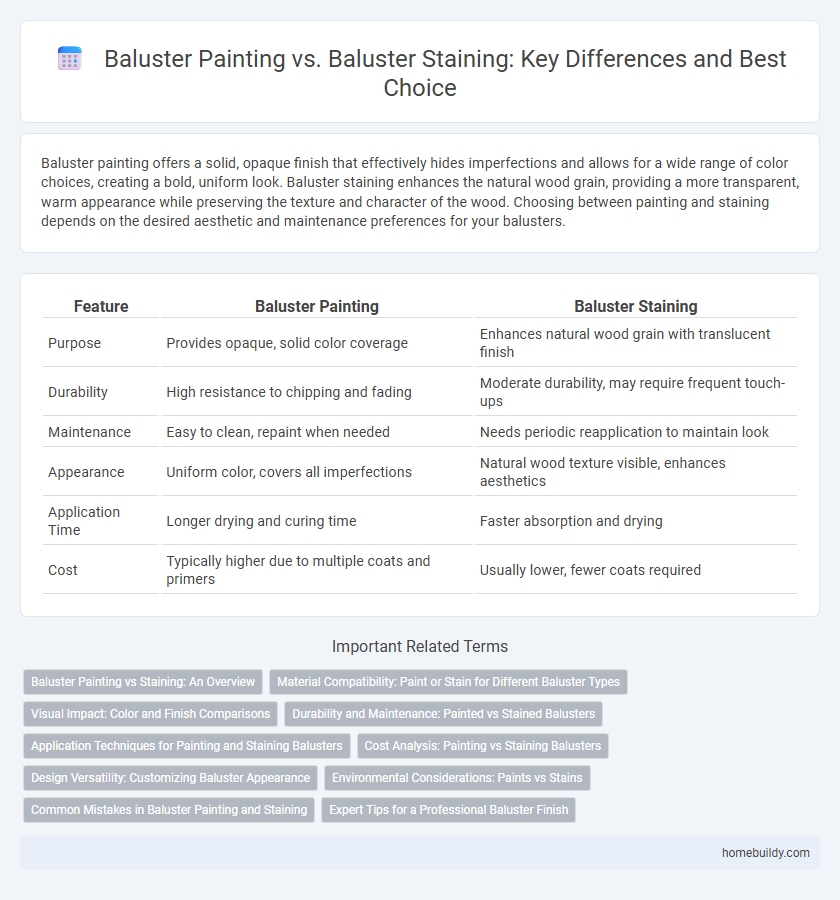Baluster painting offers a solid, opaque finish that effectively hides imperfections and allows for a wide range of color choices, creating a bold, uniform look. Baluster staining enhances the natural wood grain, providing a more transparent, warm appearance while preserving the texture and character of the wood. Choosing between painting and staining depends on the desired aesthetic and maintenance preferences for your balusters.
Table of Comparison
| Feature | Baluster Painting | Baluster Staining |
|---|---|---|
| Purpose | Provides opaque, solid color coverage | Enhances natural wood grain with translucent finish |
| Durability | High resistance to chipping and fading | Moderate durability, may require frequent touch-ups |
| Maintenance | Easy to clean, repaint when needed | Needs periodic reapplication to maintain look |
| Appearance | Uniform color, covers all imperfections | Natural wood texture visible, enhances aesthetics |
| Application Time | Longer drying and curing time | Faster absorption and drying |
| Cost | Typically higher due to multiple coats and primers | Usually lower, fewer coats required |
Baluster Painting vs Staining: An Overview
Baluster painting provides a solid, opaque finish that enhances color uniformity and covers surface imperfections, making it ideal for achieving a specific look or matching existing decor. In contrast, baluster staining penetrates the wood, highlighting natural grain patterns and offering a more durable, moisture-resistant surface suited for outdoor or high-traffic areas. Choosing between painting and staining depends on the desired aesthetic, maintenance requirements, and wood type, with paint providing vibrant colors and stain preserving natural textures.
Material Compatibility: Paint or Stain for Different Baluster Types
Wood balusters respond well to both paint and stain, but stains enhance the natural grain, providing a more rustic or traditional look, while paint offers a uniform finish and greater color variety. Metal balusters generally require paint to prevent rust and corrosion, as stains do not adhere properly to metal surfaces. For composite or synthetic balusters, paint is typically preferred for durability and coverage, whereas staining is often unsuitable due to material composition.
Visual Impact: Color and Finish Comparisons
Baluster painting offers a wide range of vibrant color options that can completely transform the visual impact of a staircase, providing a smooth, opaque finish that conceals the wood grain. In contrast, baluster staining enhances the natural beauty of the wood by accentuating its grain patterns with a translucent finish, adding warmth and depth to the overall appearance. Choosing between painting and staining balusters depends on whether you prefer a bold, uniform color or a more natural, textured wood look that showcases the material's character.
Durability and Maintenance: Painted vs Stained Balusters
Painted balusters offer a solid, opaque finish that provides superior protection against moisture and UV damage, resulting in enhanced durability, especially in outdoor settings. Stained balusters retain the natural wood grain, which requires more frequent maintenance and touch-ups to prevent fading and weathering over time. Choosing painted balusters typically reduces long-term upkeep, while stained balusters need regular sealing to maintain their appearance and structural integrity.
Application Techniques for Painting and Staining Balusters
Painting balusters requires thorough surface preparation including sanding and priming to ensure smooth, even coverage and long-lasting adhesion. Staining balusters emphasizes wood grain enhancement, involving careful application with a brush or cloth to penetrate the wood fibers without pooling. Both techniques demand multiple coats with proper drying time to achieve a durable and visually appealing finish.
Cost Analysis: Painting vs Staining Balusters
Baluster painting generally incurs higher initial costs due to the need for primer, multiple paint coats, and specialized brushes, whereas staining balusters is often more affordable with fewer materials required and quicker application times. Over time, painting may require more frequent touch-ups and maintenance, increasing total expenses, while staining offers better wood grain preservation and longer-lasting results, potentially reducing upkeep costs. Evaluating the cost-effectiveness depends on desired aesthetics, durability, and long-term maintenance commitments specific to baluster materials.
Design Versatility: Customizing Baluster Appearance
Baluster painting offers a wide range of colors, enabling precise customization to complement any interior or exterior design style. Staining highlights the natural wood grain, providing a warm, organic appearance that enhances classical or rustic aesthetics. Choosing between painting and staining allows homeowners to tailor baluster appearance, balancing bold color creativity with the richness of wood textures for unique design versatility.
Environmental Considerations: Paints vs Stains
Baluster staining typically uses fewer volatile organic compounds (VOCs) compared to baluster painting, making it a more environmentally friendly option. Paints often contain synthetic chemicals and heavier solvents that release higher levels of VOCs, contributing to air pollution and health concerns. Choosing stains with natural or low-VOC formulations reduces environmental impact while preserving the wood's natural appearance.
Common Mistakes in Baluster Painting and Staining
Common mistakes in baluster painting include applying paint over dirt or old finishes, resulting in poor adhesion and peeling. In baluster staining, neglecting proper surface preparation and uneven stain application often leads to blotchy appearances and inconsistent color. Both methods require careful sanding and thorough cleaning to ensure a durable and aesthetically pleasing finish.
Expert Tips for a Professional Baluster Finish
For a professional baluster finish, experts recommend choosing between painting and staining based on the wood type and desired look; painting offers a smooth, opaque coverage ideal for modern interiors, while staining enhances natural grain, perfect for rustic or classic designs. Proper surface preparation, including sanding and priming for paint or conditioning for stain, ensures durability and even application. Using high-quality brushes or sprayers and applying multiple thin coats results in a long-lasting, flawless finish that highlights the craftsmanship of balusters.
baluster painting vs baluster staining Infographic

 homebuildy.com
homebuildy.com